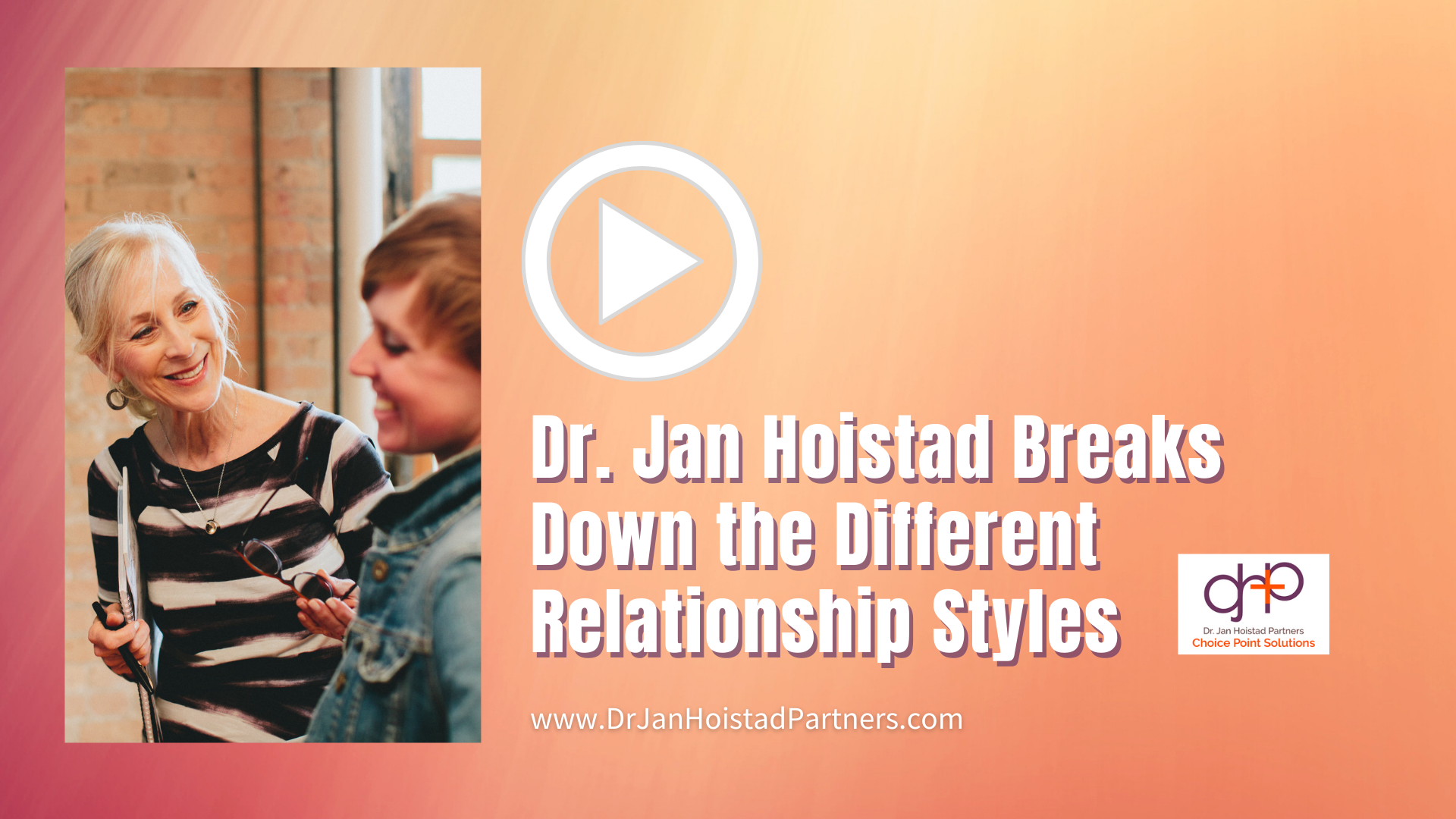
Couples lives are complicated! Integrating both your needs while also balancing work and personal or family desires can be a challenge. Knowing how to work as partners, how to come together as a team, is a choice, a value and a skill that can be developed.
When things are going well between you, your relationship and life feels good. Things work smoothly. Like many couples difficulties arise when you have to make decisions together and do not see eye-to-eye. When you want different things or have different needs. This can happen at any stage of relationship. Having the tools and skills to navigate your differences together builds a deep sense of trust. Its a sense of security and emotional connection that grows with experience as you go through good times and face life’s ups and downs together—all the while focusing on creating the relationship you desire and achieving your dreams.
This article breaks down the who, what, where and how couples can better communicate and connect to each other.
Choices of Relationship Style
So, differences are not a bad thing. They are part of life, part of our individuality and uniqueness. Sharing who you are with your mate, your partner, and finding ways to come together is key. How do you get on the same page? How do you learn to partner and work together well so your relationship grows and lasts a lifetime?
It comes down to becoming informed about different ways you can relate. Just like everyone gets educated and trained in for successful career and business development, becoming informed about how to have a great relationship should be a high priority for you. No one is born knowing how to do this. Yet everyone longs to connect.
As you read through the article you will see how I break down & describe 4 approaches or styles of relating. These are:
As we explore each relationship style, you can pay attention to the ways in which each style:
-
- Promotes healthy development of each person’s full, mature self—the individual’s independence and uniqueness, as well as the couple’s healthy interdependence, in which they come together in equal and mutually satisfying ways;
- Provides opportunities for individual as well as mutual pursuits;
- Approaches decision-making;
- Offers consistent opportunities for intimacy-building and emotional connection.
There will be links to some real life couples I’ve either coached or who have communicated with me over the years.
Then I’ll link you to a handout where you can assess your relationship right now, and compare it to how you’d like it to be. As you read, you may recognize some aspects of each style in your relationship. Most couples start with a combination of styles. When a mixture of styles exists, it is often confusing for the partners because one person may be operating under one set of assumptions, and the partner may unconsciously switch to another style and set of assumptions. Becoming conscious of this and choosing how you want to communicate and behave is key.
No matter where couples are when they contact me, having coached hundreds of couples over the years, I know the the long-lasting benefits of choosing the Big Picture Partnering approach. But let us allow couples I’ve worked with speak for themselves.
It’s Not Where You Start—It’s the Destination That Counts
You may be single, newly engaged and planning your wedding, raising school age children or even facing the empty nest and “what shall we do now?” stage. It doesn’t matter where you are right now. What matters is—identifying your destination—where you want to grow your relationship. But first, you have to know your options!
I’ve been coaching couples for over 30 years, helping them develop strong, vibrant relationships and fulfilling lives. What I know is this: Once you become informed about these 4 styles you’ll have an opportunity to decide just what kind of relationship you want to create. Then, learning the tools and skills of partnering will benefit you for a lifetime. I hope you’ll pay special attention to the benefits of the Big Picture Partnering approach and it’s benefits. This is what I coach and am passionate about as I see couples create the relationship they desire and achieve their dreams together.

In a Traditional Couple one person typically makes the ultimate decisions. Although mates can switch decision-making authority. Sometimes one makes more decisions out in the world while the other is more in charge of decisions in the home life.
STYLE 1: The Traditional (or Dominant-Non-Dominant) Style
The Traditional way of relating is the one most likely modeled by some adults in your life, maybe your parents or grandparents. While this style is shifting over time, it has been the norm in marriages for many generations and across many cultures. You may recognize aspects of this style in your own relationship.
Diagrammed, the Traditional Relationship Style would look like this:
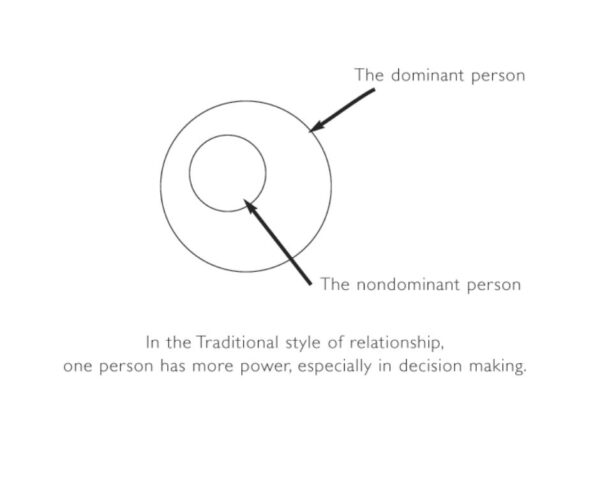
In the Traditional style one person has more decision-making power than the other. This does not necessarily mean that the dominant partner misuses or abuses his or her power. What it does mean is that one person in the couple usually makes the ultimate decisions. One person in the couple may take on this more dominant role because the couple has assigned this person the decision-making authority, or because one partner is more forceful, the other more passive. In the past, the man often assumed the dominant decision-making role, simply because both partners followed tradition. Sometimes the man wields decision-making power over more worldly aspects such as finances, and the woman makes most of the decisions about the home, child-rearing and social activities.
If you find aspects of your style as Traditional, use the four dimensions above to assess whether the style is chosen consciously, as a healthy combination of interdependence and independence, or whether one or both of you are simply avoiding making decisions or conflict by allowing your partner to take the lead. This would stifle your individual healthy growth. It would also limit intimacy-building and emotional connection because you are not sharing your true self. Whether the people within a Traditional relationship promote independence and interdependence is highly dependent on each couple. Sometimes a Traditional couple will do most things independently. He goes to work and hangs out with the guys; she raises the children and has her work and hobbies and friendship activities. They may come together around dinnertime, religious activities, some social engagements, and children’s after-school events.
Some Traditional couples are very emotionally connected. Others do not know one another much at all. They choose to continue their Traditional style because they may not wish to reveal themselves, or they may not wish to do the work it sometimes takes to become close.
Many Traditional couples report satisfying relationships, and some point out that it results in successfully circumventing potential power struggles and conflicts. Some even feel it is a God-given preference. The Traditional style can spell out roles and tasks very clearly when there are young children to raise or when one person has the main bread-winning function and is on a career path that requires intense involvement. You might know a couple like Al and Sharon, who exemplify the Traditional style.
The opportunity for connection and intimacy building in the Traditional style is dependent upon the choices, needs, and desires of the person with the most power. When that person, usually the husband, feels that time with his partner is important and valuable, then talking, affection, and sex may occur on a regular and mutually fulfilling basis. If, however, the dominant person is out of touch with the other person’s needs, or simply doesn’t think those needs are important, then connection and intimacy is missing.
In the Traditional (or Non-Dominant) Style
One member of the pair is dominant and makes the ultimate decisions for both partners. One may be dominant in all aspects of life or may take over dominance in certain aspects of life. In the Traditional style the emotional connection and opportunities for intimacy building vary for each couple because the degree of closeness and sharing is dependent on the desires and expectations of the person who is more dominant.
STYLE 2: The Merged (or Undefined Roles) Style
In the Merged style of relating, individuals have few personal boundaries and little autonomy. They think, feel, and act interdependently in most areas of their life. They sometimes appear inter-changeable in their thoughts, feelings, interests, and desires. Many couples have some Merged qualities; I have worked with only a few couples who were Merged in many ways. In one circumstance the woman wanted to grow, in another both partners realized they needed a more mature relationship. I think this is probably because fully Merged couples seldom seek outside help because they are so self-contained.
What is important is for you to identify small ways in which you may be Merged in your relating style, and to determine if these ways of relating are right for you. Diagrammed, the Merged Style would look like this:
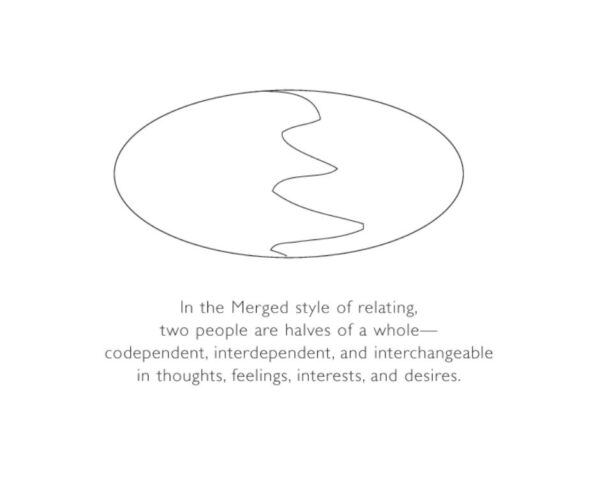
Decision-making for a Merged couple appears seamless because they go along with each other because they seldom do or decide anything that would be surprising or unusual. Typically they stick to prescribed and expected choices, decisions, and responses, and they know exactly what to expect from each other. Often the person who is the least passive at that moment voices a preference and the partner just goes along. Sometimes this is because one or both feel they cannot say what they want so they give in to their partner; sometimes it is because striking out independently causes their partner to become angry, unhappy, or to feel betrayed.
From a mental health perspective, this is not good for individual development. Merging results in co-dependent and care-taking behavior. Individuality is sacrificed in doing what others want—or what you surmise others want of you. Examples include a person who never offers an idea about what to do on a date; or someone who is always rubbing your back or getting you a cup of tea, even when you may not want one. They may want the back rub or the cup of tea and they unconsciously hope you will know this and return the favor. Sometimes people call this being “nice,” but when it is overdone, one individual sacrifices herself, her needs, wants, and desires for the other.
When you’re around such couples, you might notice that they may finish each other’s thoughts—not just sentences—and have such a uniform point of view that they seem to have little individuality. Their closeness may appear as intimacy, while their responses or thoughts may seem rote, rigid, and routine. They are often inseparable, sometimes in an almost charming way, as in very old couples who have been together for fifty or sixty years. However, when one partner is away, the other one doesn’t know what to do, or even think, because they are truly lost, being dependent on their other half.
During courtship and falling in love, it is not uncommon for couples to become somewhat merged as they explore all the ways they are alike. It is healthy and normal however, to let individual autonomy emerge as the couple discovers their differences in later phases of courtship. It is at this point that couples either break-up—not wanting to “unmerge,” and mistakenly thinking that differences mean there is something wrong with or incompatible in their relationship—or they unmerge and work to appreciate one another’s unique qualities and how they enhance the budding relationship. They desire individuality in their relationship in a way Merged couples do not.
Some couples evolve into a Merged relationship if they are together for a long time and fail to develop individual interests or receive support for individual growth. Younger couples, too, can become merged—especially teenage brides and grooms, who wed before their individual personalities are fully formed. Meet Chet and Sue – a perfect example of a Merged Style Relationship. Their story illustrates how the Merged style does not support individuality and how change is challenging.
When they’re alone, the individuals in a Merged couple may feel vulnerable. They only feel whole and safe when they are together. If we imagine couples in the context of the larger world, such inter-dependence requires that neither of the Merged partners grow personally nor develop outside interests. Between the couple it means they must rely on keeping the spark and continuing to interest one another just as they are, with no surprises, changes, or uniqueness. Such limitations cause great strain, especially if one person desires more.
Decision-making for the Merged couple occurs by unconsciously doing what the couple feels is typically expected of a husband or wife or mate without giving much thought to other options. Merged couples often make their major decisions early in their relationship and seldom question them. In addition, without an awareness of individual needs and feelings, the Merged couple is not able to understand and share true intimacy, which requires the coming together of two whole, mature selves who are growing and changing, who support these processes in one another, and who are also developing new interests together over time.
In the Merged (or Undefined Role) Style
Decisions appear to be made early in the relationship and then stuck to indefinitely, or until one person becomes dissatisfied. At that point it is difficult for this couple to learn new patterns, because first they must learn to be whole, individual adults, then they must learn to be interdependent in healthy ways. Decisions for this couple are made unconsciously by adhering to what the couple feels is typically expected of people when they fall in love and marry. It appears as though the couple is always in agreement, but the agreements are within a narrow range of what is acceptable and expected.
In the Merged relationship, the two people are fused rather than separate individuals intimately connecting through communication and interaction. They spend a lot of time together, but do not know how to be apart. This is not developmentally healthy for either of them. It also limits the potential for developing a mature intimacy. Therefore they may think they are emotionally connected, but they are not truly intimate by definition.
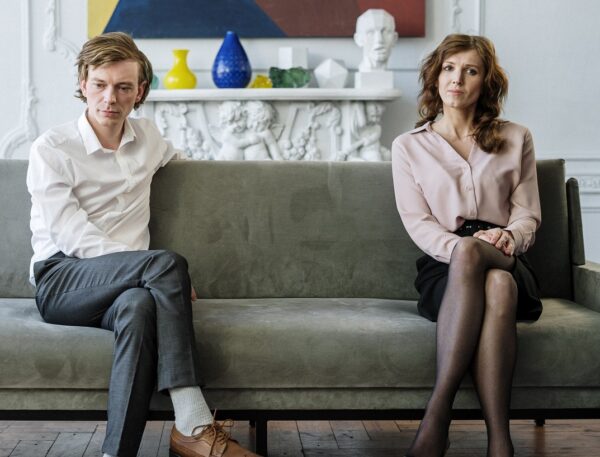
The Roommate Style of Relating can appear and feel quite successful, especially between highly independent types who accommodate—or work around—one another. It goes awry when one person wants something different. Then they do not have mutual decision-making skills and can feel blind-sided not knowing how to proceed.
STYLE 3: The Roommate (or Unilateral Decision-Maker) Style
The third model of relating applies not only to actual roommates and friends, but to long-term couples as well. When applied to couples in a long-term romantic relationship, the Roommate style typically describes two people of equal power and competence who share a home and other significant aspects of their lives. In addition to living together, they typically have sex, share some friends, and may even have a child. A major defining characteristic of the Roommate style is that individuals in the couple each make decisions unilaterally, without taking their partner into consideration; they may do this consciously or unconsciously. Some profess to value the independence but they do not balance it with inter-dependence that is necessary in any healthy, mature relationship.
Diagrammed, the Roommate Style would look like this:
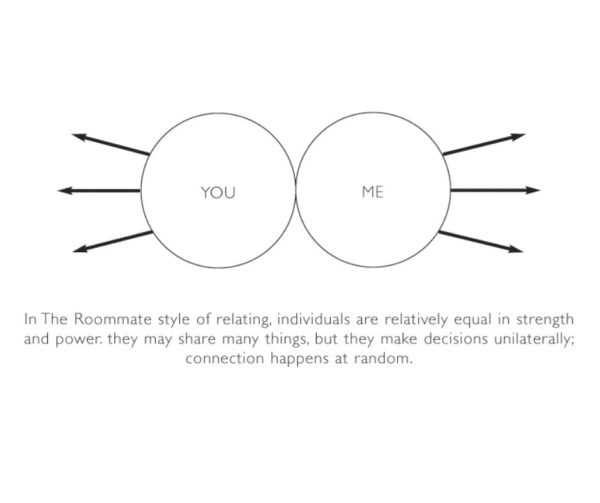
For instance, a woman may come home one evening and tell her partner she’s going out with her friends on Friday night (implying that he has to watch the kids, get a sitter, or fend for himself ). Or a man might not feel it necessary to consult his partner when he chooses to quit or change his job—or even move his family across country for a better position. It is assumed that the other partner will make adjustments as necessary. Because they always have. Let’s look at the relationship of Rahlah and Jeremy.
Partners in the Roommate style of relating come and go pretty much at will. This is done with the expectation that the other person, and maybe even the children, will make necessary adjustments without any discussion. Sometimes this works and people are happy with the outcome, but when it doesn’t work, at least one person will be left unhappy and, sometimes, unaware of what is wrong.
What distinguishes these relationships is the independent activity of each person. Each makes solo decisions, even when decisions affect both partners—and perhaps an entire family. In this style, one partner’s needs and concerns may or may not be taken into consideration. Decision-making is one-sided, even when the deciding partner has the best of intentions and feels that she is accommodating her partner’s unspoken desires.
Another defining characteristic of the Roommate style is that opportunities for emotional connection occur only randomly, since partners tend to function independently. This means there might be a steady connection at times, but only a sporadic connection at others. Partners cannot count on feeling emotionally connected to one another, and often they cannot count on their partner doing what they might choose to do for an activity, because they are used to making plans separately. Therefore if they both wish to spend time together on Tuesday evening after work, the connection time is satisfying to both of them. Whether they are able to feel emotionally connected cannot be counted on, however—sometimes it may happen, and sometimes not.
While some couples consciously choose the Roommate style, many don’t actually set out to become Roommates. Those who consciously choose to act as Roommates tell me they value their independence. They seem to feel that relying on each other will take something away from their life. So they stridently talk about independent decision-making. Frequently these couples become emotionally disconnected.
The couples that unconsciously fall into the Roommate style of relating often tell me they simply thought it was working for them. And sometimes it does, when they are both choosing to be together, and when they are both involved in other activities at the exact same time.
Modern couples with their busy lifestyles, careers, and family responsibilities often fall into this style by default rather than choice. Many of them have never really learned how to build and sustain a truly intimate partnership. Perhaps they saw their parents relating in this way, or the Roommate style may have unconsciously developed as a way to avoid closeness—the result of previous disappointments and the inability to trust. Some of my coaching clients point out that the Roommate style can result from having to be strong and independent in their jobs and careers, which filters into the relationship.
Some couples have relative success in the Roommate style when life is going fairly smoothly. I have also heard of couples being satisfied with this model when one or both have easy-going, non-goal-oriented personalities. Typically this relaxed attitude is accompanied by knowledge that “my partner probably wouldn’t change even if I asked him.” Or, as in any of the previous styles of relating, one or both individuals are conflict-avoidant and they simply settle for being Roommates because they don’t know what else to do to feel more satisfied. Because partners cannot always count on connecting with each other, the Roommate style often leads to misunderstanding and dissatisfaction for one or both people.
In the Roommate Style
Decision-making is unilateral. Each person makes decisions individually, without necessarily consulting the other. The expectation is that each person will adjust to the decisions made by the other. Opportunities for independence and individuality are high; interdependence is low. Emotional connections may happen frequently, intermittently, or very seldom, depending on each person’s choices at any given time. While there may be two whole individuals in the Roommate relationship, this style results in limited opportunities for intimacy building, at best.
Reading this section you’ve probably begun to identify some of the ways you relate that have led you to desire change. In the next section you’ll be introduced to another style of relating called Big Picture Partnering. This may be the style of relating you’ve been longing for.

Couples who embrace the Big Picture Partnering approach to relationship trust their connection and feel confident and secure in their skills.
STYLE 4: The Big Picture Partnering Relationship
Two People, One Journey
In the Big Picture style, you mutually create three worlds, which are encompassed in a larger partnering universe in which your relationship is:
- Supported and strengthened by your commitments;
- Nurtured by positive feelings, regular talking and listening, and essentials that build trust and connection;
- Strengthened by your uniqueness – two lives, needs, desires, and dreams – which you bring to the relationship;
- Solidified as you come together to create a mutually satisfying Our World; your issues and concerns, dreams, and desires go on the table for discussion; only win/win solutions go inside Our World.
The Big Picture Partnering Universe
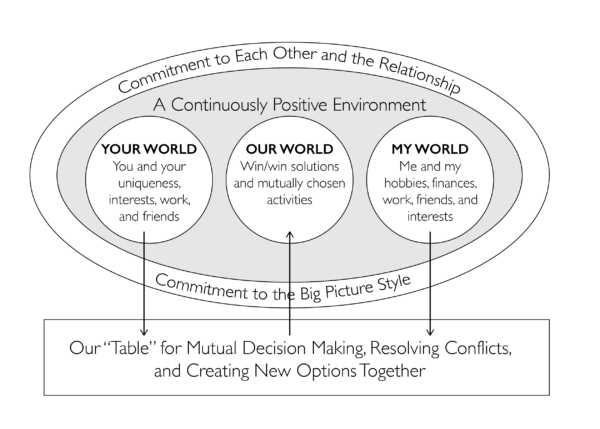
In this diagram, the circle on the left symbolizes Your World, which comprises all your individual uniqueness, friends, work, finances, activities, and so on; the circle on the right is Your Partner’s World, which comprises all these aspects of your partner’s life. Each of you has a high sense of individuality in this approach. The center circle—Our World—encompasses the mutually chosen and mutually created aspects of your life as a couple which only two unique human beings can build together.
The Our World circle represents the healthy interdependence you can have while retaining your individuality and some independence. The parts of your life that you share and enjoy together you put into Our World. They are like the glue for your relationship. The Our World circle can include kids, house, mutual friends, finances, travel and vacation plans, hobbies or learning activities, religious or spiritual activities, exercising together, and so on. Our World contains elements that each couple agrees on together. Nothing goes into Our World unless it is a win/win, mutually satisfying decision.
You will notice in the diagram that there is a field surrounding the three worlds: My World, Your World and Our World. This is not a dead space. It is meant to represent the many positive behaviors and communications that keep your emotional connection alive. Outside of that field is a larger circle of commitments that protect your special relationship. Each element is indispensable in the Big Picture universe.
You will also notice in the diagram a table just outside the Our World circle. This symbolizes the Big Picture approach to communication and to reaching an agreement together. Rather than putting your concerns, disagreements, or differences between you, where they cause you to blame or become angry and disconnected from one another, in Big Picture Partnering each partner brings their thoughts, concerns, needs, wants, and desires to the table, where they are freely discussed until the two of you arrive at a mutual decision about how you want to act.
In Big Picture Partnering, having two strong individuals, as Irina and Milo demonstrate, is important. By learning the tools and following the steps of Big Picture Partnering, which you will learn in these modules, all three worlds can coexist harmoniously. If you choose this approach, you will practice developing and balancing all three worlds in order to enjoy a richer and
more rewarding relationship.
If you haven’t already, download the assessment of styles of relating and reflect on how you’d like your relationship to be. You can find this on our FREE Resource page – You’ll be guided to think about where you’ve been and the destination you desire. What has characterized your relationship up to this point in your lives, and how would you like your relationship to look a year from now?
Let’s review some of the key benefits of Big Picture Partnering
Making Decisions Together
When you choose the Big Picture style, the way in which you and your partner make decisions is quite different from those of the other three styles. In the Big Picture, Our World decisions—those that involve both people—are made together. Your World and My World decisions are made individually, but are supported by each partner.
In Big Picture Partnering any issue can be brought to the table for discussion; however, nothing goes into the Our World circle until it is fully agreed on by both individuals. Big Picture decision-making is not necessarily about compromise. Nor is it about neglecting your own needs in order to attend to those of your partner. Rather, it challenges both partners to become imaginative and to recognize or invent new options together. This approach helps you master the fine art of blending each of your needs into something totally new and unique—an Our World that satisfies both of you. Take a look at the example of Marybeth and Ron.
Connecting—and Staying Connected—in a New Way
How does Big Picture Partnering allow for a new kind of connection? The Big Picture style does this by enhancing and drawing on each other’s individuality—primary requirement for true connection and intimacy. Big Picture relationships nurture emotional connection and provide many consistent opportunities for intimacy.
If you choose the Big Picture approach, you will clearly experience the many and consistent opportunities for communication and connection that are built into partnering. At first you will be guided to communicate in small increments and to apply these communications to important daily basics. Gradually you will expand these skills as you apply them to deeper issues that may have been more difficult to resolve in your past. Then you will go on to apply your new communication skills to creating your future dreams together.
Communicating and interacting, in and of themselves, do not ensure that you will feel emotionally, mentally, or spiritually connected all the time. That is unrealistic. Take the example of Pete and Barb who love one another and are raising a family. They were in great pain when they came to me for couple’s coaching. Life stressors caused Pete to revert to angry outbursts and hostility toward Barb and the kids. These were behaviors he’d experienced in his family growing up with a dysfunctional father as role model. With hard work and learning new ways, they successfully made changes in their relationship. But it wasn’t always easy.
Not every couple is as extreme as Pete and Barb. However all couples experience some squabbles brought on either by differences or by outside pressures. Big Picture Partnering will help you create more opportunities for meaningful communication and connection, so you more easily address everyday details. As you successfully handle these issues, you’ll feel less stuck. You’ll have left-over energy for future Big Picture goals.
Balancing Individuality and Mutuality
Big Picture Partners bring to their relationships two distinct and unique individual selves who consciously choose to be connected. They desire to support each other’s strong sense of individuality while also promoting the mutual decisions of the Our World circle they create.
Some couples find this easy to do in the beginning of a relationship, but over time—especially when children or demanding work responsibilities are introduced—remembering to take some time for each of your personal interests and for each other can be challenging. What’s important is to value one another’s needs as much as you value your partnership and your children’s needs. Then you aim for the best balance possible, which may vary from week to week as you try to get in that workout, dinner with girlfriends, or golf game with the guys.
Discounting or overlooking these needs for too long can lead to resentment. Even children do best when parents are caring for their own and one another’s needs while also providing positive parenting. When couples support and work to balance both individual and couple needs, the resulting relationship becomes a mutual creation made of the inspiration, imagination, personal histories, experiences, gifts, and resources of the two partners.
Learning to Be Creative and Find New Options Together
Learning to come up with new options or solutions to your needs and problems is a skill you will want to learn through the tools you’ll learn in the modules. Doing this together will make you feel good about yourselves and one another. The new options you invent together can be applied to everyday problems you face such as who’s going to do the meal planning, grocery shopping, and daily cooking when both of you work full time. Such creative solutions are definitely required if this is your second marriage and you are trying to meld two households and one or two sets of kids, exes, and in-laws. Coming up with new options is also necessary as children get older and are able to participate in household chores or require more juggling of schedules as you take them to games or extracurricular activities.
As you learn to problem solve together and apply your creative options to everyday issues, these wrinkles will begin to smooth out. Once this happens, Big Picture Partners discover they then have more time to develop their Big Picture dreams together—no matter what your age or stage in relating. Let me tell you about Harvey and Lenore.
Daily Details and Big Picture Dreams
Why is it that we rarely manage to resolve with our partner those constant arguments about the little things in life? We spend so much energy hassling over whose turn it is to do the dishes, why the kids aren’t finishing their breakfast, or which set of in-laws to invite for the holidays.
Big Picture Partnering will provide you with a set of tools to apply solutions to daily problems. For each couple, the list of issues that cause frequent arguments will be different, but you’ll do an inventory of these so you can pinpoint the ones that nag you the most. You’ll cover everything from finances and chores to parenting, in-laws, friendships, and vacations. You will be guided toward creative problem-solving with your partner, so the two of you don’t have to spend all of your energy on the same day-to-day problems. Former problem areas will become comfortable, agreed-on routines. As a result, your creative energies will be freed up for your Big Picture dreams and visions, or for simply more fun and play.
You Relationship Adventure: The Big Picture Way
Now that you’ve learned about the different approaches to relationship you may desire to learn more.
Whether you are new to relationship, heading toward matrimony, planning your family or looking at life after empty nest, you want to stay in love, stay connected and have a thriving next phase of your life together. If you are experiencing difficulties and want to learn a new way or you simply want to make a good thing even better, be sure to read on for ways work with Dr. Jan.

- If you haven’t already, download the assessment of styles of relating and reflect on how you’d like your relationship to be. You can find this on our FREE Resource page – You’ll be guided to think about where you’ve been and the destination you desire. What has characterized your relationship up to this point in your lives, and how would you like your relationship to look a year from now?
- You can always contact Dr. Jan directly – Reach out for a complimentary discovery call to discuss your needs and best ways she can help.

